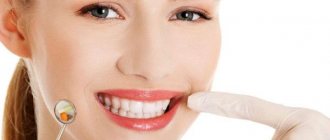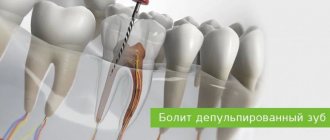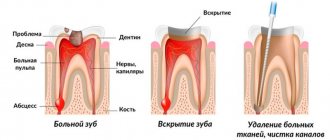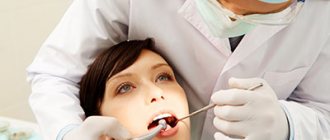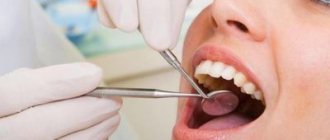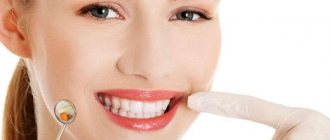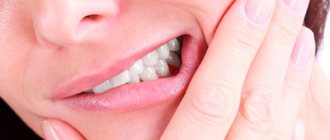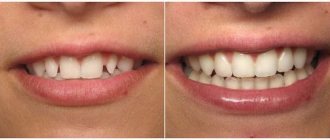It happens that after dental procedures, toothache does not go away. It may become smaller, less pronounced, and sometimes pain occurs only when you press on the tooth. Does this mean that the doctor did not complete the tooth treatment? What do pain sensations indicate immediately after treatment, how to respond to them?
After treatment of a tooth it hurts to press on it
Usually, a visit to the dentist solves the problem completely - the tooth is cured or, which is also sometimes necessary, removed. Almost always, the dentist warns you what sensations may appear soon: whether the tooth or gums will swell, how long they will last, and in what case you need to come back for an appointment.
If a tooth is removed, there may be slight pain at the extraction site throughout the day. This is normal, because the hole after removal is a living wound that needs time for tissue restoration. Roughly speaking, the wound should calm down and heal. But if the pain does not subside for several days, it is strong, throbbing, the swelling does not go away, you need to go to the doctor.
If the pain does not subside after treatment or removal, you should consult a doctor.
Why else can a tooth hurt after visiting a doctor?
There are several other reasons that explain toothache after a visit to the doctor. These are only possible options; you should not make diagnoses on your own. As a rule, the doctor gives a guarantee on the filling, and if pain occurs, he is obliged to see you, and this visit will be free.
Why else can a tooth hurt?
- Partial removal of pulp tissue. May cause re-inflammation.
- The caries has not been completely removed. If the tooth is seriously damaged, a temporary filling may be necessary. If for some reason the doctor underestimated this measure, the toothache may become even worse due to incorrect therapy. The fact is that in a completely closed area the inflammatory process will be more severe than in an open one. And secondary inflammation in an already clean area can no longer lead to caries, but to a more serious process - pulpitis.
Pulpitis
- Allergy. A rare case, but it cannot be ruled out. Increased sensitivity to the filling material can cause inflammation and pain in the tooth area.
- Failure to comply with medical recommendations. For example, the doctor told him to abstain from food for some time (usually no more than two hours), but the patient ignored the recommendations.
Violating medical orders can be dangerous
So, pain in the treated tooth, which can occur periodically at certain points, should go away within 2-3 days. If the pain lasts more than a week or two, you need to go to the doctor and find out what went wrong.
Causes of pain
After pulpitis, a tooth hurts for several reasons - damage to the tissues surrounding the tooth root (periodontal) or an inflammatory process.
Tissue damage can be caused by the following circumstances:
- formation of a wound surface during removal of the neurovascular bundle of a tooth;
- treatment of root canals with antiseptic agents if the antiseptic leaves the canal.
Can a tooth hurt after pulpitis due to the dentist’s dishonest work? The inflammatory process can occur due to poor quality work by the doctor. Signs of poor treatment of pulpitis on an x-ray are:
- incomplete filling of root canals, when there is still free space left to the apex;
- excessive filling of root canals, when the filling material extends beyond the apex of the root canal;
- extra holes in the root canals.
How to prevent pain after therapy
There are some simple preventive rules that will prevent possible negative consequences of treatment. The first thing is not to violate the doctor’s recommendations. If it is said that you cannot eat for two hours after taking it, then do not violate the instructions for even a minute.
If the doctor told you not to eat for 2 hours, you need to follow the instructions.
If you smoke, then in the next few days after treatment you should reduce the number of cigarettes you smoke as much as possible. It goes without saying that you should give up sweets.
You will also have to give up sweets for a while
Hot or cold foods should also be prohibited; they act as an irritant to the injured nerve endings of the tooth.
It is better to cool drinks and dishes that are too hot
In the first days, it is worth including more liquid and non-solid food in the menu, which is not necessary to bite into. Also, for the first time after treatment, reduce the load on the treated tooth. Chew them intensively; you definitely shouldn’t bite them.
- It hurts to chew on a tooth
Chicken broth is an excellent dietary dish that will not harm your teeth and gums
Of course, it makes no sense to use untested, questionable pain relief recipes. There is no need to run for a painkiller if the pain appears only occasionally, when biting, and immediately disappears. Of course, after treatment, avoid serious physical activity; it will be stressful for the body.
Classic filling
The conventional filling procedure does not imply penetration into the tooth pulp and depulpation of the root canals. This manipulation is much simpler compared to endodontic intervention, however, not everything is so obvious here. First, conventional therapeutic procedures are performed more frequently. Secondly, the quality of materials and the level of specialists in Russia are often low, so severe pain after filling a tooth and other complications are by no means uncommon even with the simplest manipulations. Below is a table that describes the most common causes of complications and pain after filling.
| Type of complication | Description | Pain symptoms |
| Mechanical trauma to the pulp during filling (pulp perforation) | It occurs when the bur is used roughly and carelessly, when the partition between the pulp and dentin is destroyed. Modern dentistry offers conservative ways to eliminate such complications, but often only a depulpation procedure can help. | With this problem, the tooth “pulsates” after filling and reacts sharply to cold and hot. The pain is severe and practically does not subside. |
| Burn of dentin or pulp (tooth overheating) | Usually occurs when the cooling system of the drill malfunctions, when the tooth tissue gets burned during the operation of the drill. In the most severe cases, the patient develops pulpitis and periodontitis. | If your tooth ache after filling and the pain does not go away for a long time, it is quite possible that you have a dentin burn. If, after filling, the tooth reacts sharply to hot and cold or there is throbbing pain, then most likely the pulp was affected. |
| Incorrectly installed seal | Overbite and overhanging filling edges are among the most common causes of pain. Incorrect closure of the dentition provokes very unpleasant sensations. | Does your tooth hurt when you bite it after filling? Perhaps the problem is an incorrectly installed seal. If the cause is not eliminated in time, the tooth reacts painfully even with gentle pressure. |
| Error when choosing material | There are more than a dozen filling materials on the market, many of which are not suitable for everyone due to their properties and components. | Acrylic composite and silicate cement fillings can cause allergies and inflammation. Amalgams and some light fillings can shrink, which is why the tooth hurts quite noticeably when bitten after filling. |
| Gum injuries | Damage to soft tissue is a very common occurrence during therapeutic manipulations (especially in the treatment of cervical caries). Serious injuries may require gum grafting. | Aching or cutting pain at the site of gum damage. |
What symptoms after treatment require urgent consultation with a doctor?
How can you understand in the first days after dental treatment whether the pain is physiological or the process is already pathological? There are some signs that indicate that you need to see a doctor without delay.
The following symptoms are considered abnormal after dental treatment:
- the pain in the filled tooth pulsates, it is sharp and sharp, and there is no tendency to decrease it;
- pain radiates to neighboring teeth, ear, temple, neck;
- body temperature rises;
- headaches appeared;
- cheek swollen;
- suppuration in the tooth area;
- inflammation of the gums;
- there is a feeling that the filling is in the way in the mouth.
If you have a headache or fever, you need to see a doctor
Possible pain after dental treatment
| Norm | Pathology |
| It hurts to press, press, or bite on a tooth for 2-3 days (maximum – a week) | Increased body temperature |
| Slight lifting of the gums | Pain radiates to the ear, temple, neck |
| Slight pain after the anesthesia wears off | Headache |
| Increased sensitivity and pain when exposed to cold food and liquid, as well as hot, spicy, sweet, sour | Severe swelling of the gums and/or cheeks |
Even if the required two days have not passed after therapy, during which the pain should go away, do not hesitate to visit the dentist. It is necessary to stop the inflammatory process and treat the tooth. Even if the alarm is false, you need to make sure that everything is in order. In this case, the patient’s increased suspiciousness is even encouraged.
Dental filling is not the most complicated process; it is not a surgical intervention. But often this work can be compared to jewelry. Therefore, unfortunately, some problems cannot be ruled out - the doctor may make a mistake. It is good if the patient is treated in a proven clinic with a good reputation, perhaps with the same doctor.
It is best to have your teeth treated in a good clinic
Happy treatment!
Caries
If after treatment the tooth hurts when pressing or eating, this is considered normal and can persist for up to two months. This is explained by the fact that with deep caries, a very thin layer of dentin remains between the pulp and the filling, so when pressing or biting, pressure is transferred to the nervous tissue and causes pain.
In addition, the patient may experience dull pain for 14 days. This is also considered normal and is explained by a reaction to the use of boron, as well as various medications. But, if even after two weeks the discomfort does not go away, you need to contact your dentist.
Acute or throbbing pain is a reason to visit the dentist immediately: perhaps a carious infection has penetrated into the pulp, causing pulpitis. The sooner you do this, the higher the chance of avoiding the removal procedure and the subsequent need for prosthetics. You can learn how to avoid caries from the article “Prevention of caries.”
Why does a healthy tooth hurt?
A seemingly healthy tooth without any damage or caries can also hurt when biting.
The reasons for this are increased sensitivity of the enamel. Pain occurs both from mechanical stress and when eating hot, hungry or sour foods. The discomfort is short-term and goes away immediately after the irritant is eliminated.
2 ways to get rid of enamel hypersensitivity:
- Do-it-yourself is the home use of gels and pastes based on fluoride, calcium and other useful minerals (ROCS, SPLAT Biocalcium, Colgate Sensitive, Elmex, etc.).
- Turning to the dentist means professional fluoridation of enamel, remineralizing therapy, as well as enamel extension with filling material.
What can hurt a tooth?
A tooth consists of a root and a crown. It is covered as a frame with dentin and cement in the root area, dentin and enamel in the crown area. These are hard tissues that lack nerve endings, so they cannot hurt. Inside the tooth there is a space filled with tissue penetrated by branches of nerves. This is pulp. The pulp is also contained in the canals that connect the tooth cavity to the root. Any diseases (for example, inflammation - pulpitis) and injuries to the pulp are very painful.
Periodontitis is also a very painful disease - inflammation of the periodontium - the ligament that holds the root in the socket, since there are also many branches of nerves in the periodontium.
